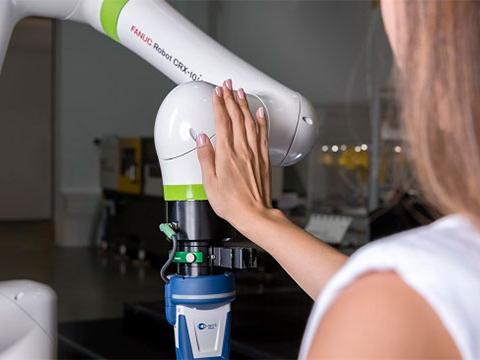
Posted to News on 15th Aug 2022, 13:14
UK now accelerating towards automation

Tom Bouchier, managing director of Fanuc UK, says there has never been a better time for UK firms to invest in automation. Here, he outlines the key changes within the automation landscape that are prompting British firms to finally wake up to the benefits of automation.
Despite our relatively small landmass, the UK is an economic overachiever, ranking as the fifth largest economy in the world. Linked to this is our success in manufacturing – we are the ninth largest manufacturing economy, the third largest aerospace manufacturer, and our premium auto sector is one of the most powerful in the world. But concerns have been raised about our potential to retain our reputation as a manufacturing powerhouse, largely because of a chronic labour shortage and diminishing productivity rates.
At the heart of this is our historic reluctance to automate – the UK currently ranks 24th in the world for robot density, with 101 robots per 10,000 workers. This is way below the global average of 126/10,000 employees and far less than Germany with 371.
Skills shortage takes hold
Latest figures from the UK’s Office for National Statistics (ONS) confirm that unemployment in Q1 of 2022 was around 3.8%, a record low. Some sectors are experiencing particular shortages; in May 2022, the Association of Labour Providers (ALP) reported that almost half (49%) of British food growers have rationalised or reduced their output because of labour shortages. Monitoring firm Small Business Prices has reported some startling figures in manufacturing, too; mechanical engineering vacancies are 24.1% above average in the northwest and nearly 16% in London.
Long-term staffing pressures have been exacerbated by Brexit and the Covid pandemic, during the early part of which, in 2020, there were four unemployed people for every vacancy in the UK. The ratio is now 1:1, according to the Chartered Institute of Personnel and Development. Demand for workers has risen at a time when the supply of labour has been limited. And the reopening of the economy as the pandemic loosens has only made the situation even tighter.
Automation is the answer
To remain competitive, industrial companies need to produce more goods, to higher quality, in less time. This is hard to achieve with human personnel alone, especially given the current skills shortage. The way to resolve these pressures is through automation – using robots to do the dirty, dull and dangerous jobs and freeing up workers to complete more value-added tasks.
Although the UK was slow to the robotics revolution compared to many other industrialised nations, at Fanuc, we are now seeing a significant uplift in enquiries across the UK and Ireland, and especially from SMEs who have not, historically, been major users of automation. Automation and roboticization in UK manufacturing has been led by the automotive sector, concentrated within the OEMs and Tier 1 and Tier 2 suppliers. Further along the supply chain, reliance on human employees and manual workers has continued.
Cost: overcoming the big hurdle
There are a number of reasons why UK manufacturers and employers, particularly SMEs, have been reluctant to invest as rapidly as their counterparts elsewhere in Europe and across the world: chief amongst these is cost. There is a perception that robots are expensive, and this was undoubtedly true in the past. But as robots have become more agile, more flexible and more adaptable, their purchase price has dropped accordingly.
The days of one large, bespoke, immovable robot, surrounded by heavy guarding, doing one standardised job over and over are gone. Today’s automated solutions take up a smaller footprint, are lighter, and can often be easily redeployed as business needs evolve to meet changing consumer demand, making them a lasting investment that can continue to add value for years to come.
Lifetime costs have come down, too. At Fanuc, we actively work to design and develop robots that are energy efficient and durable, that operate reliably and cost-effectively for decades with minimal maintenance. To illustrate the cost-benefit ratio and payback timescale to UK manufacturers, we are developing a return on investment (ROI) calculator tool. Due to be released later this year, it will enable customers to input appropriate parameters – initial cost, speed of operation, load times, etc – and calculate the value of their investment in automation in clear, cash terms.
Cobots: flexible, agile and inexpensive
Chief among the new generation of flexible and adaptable robots being developed are collaborative robots, or cobots. These machines can be liberating for smaller companies and pretty much eliminate cost concerns. We expect to see more cobots working in factories of the future, automating tasks that have, until now, been difficult to roboticise.
Designed from the outset to be sensitive to the presence of people, cobots can be used in applications alongside humans. Depending on the application in question, the traditional expensive safety infrastructure associated with industrial robots is not always required. This, as well as their smaller footprint, helps to reduce their purchase price. Their ongoing lifetime costs are refreshingly low, too – Fanuc’s CRX range of collaborative robots comes with a guarantee of eight years’ maintenance-free operation.
Another key factor influencing manufacturers’ decision to invest in cobots is their ease of set-up. For example, developed in partnership with one of our integrator partners, Cyber-Weld, the CyberMate is a ready-to-use cobot welding system. Its plug-and-play operating system makes it a flexible, low-cost, high-value solution that can be rapidly reconfigured for the needs of SME operations.
Connectivity: optimised for the digital age
Another factor helping to make automation a more attractive option than ever before is connectivity. Machine tools and robots are becoming more intelligent. Industry 4.0 means that all devices in the factory are interconnected. An inevitable consequence of this is a trend towards standardisation of CNC applications across a range of manufacturing technologies.
At the same time, availability of data from machines in operation, in real time, is helping to improve quality, reduce unscheduled stoppages and boost productivity. These things are in reach of even smaller companies.
Digital twinning is another trend that is proving beneficial to larger and smaller companies alike. Developed in conjunction with a physical system, the digital twin can help manufacturers that are looking to scale up, alter or enhance their production lines. By running a virtual version of any changes through the digital twin, they can have confidence that their automated system can handle them before investing in any new equipment, boosting uptime and eliminating the risk of ending up with a system that is not fit for purpose.
Although robots are constantly evolving and becoming more affordable, more accessible and more attractive, people will always be needed in factories. Where automation can really make a difference is in improving working conditions by taking over physically demanding, repetitive and hazardous tasks, leaving the human workers free to deploy their skills into more valuable areas, and ensuring that the UK’s legacy as a manufacturing powerhouse can continue to thrive.
Want the latest machine building news straight to your inbox? Become a MachineBuilding member for free today >>

















